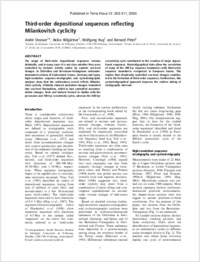Third-order depositional sequences reflecting Milankovitch cyclicity
- Strasser, André Geology and Paleontology Unit, Department of Geosciences, University of Fribourg, Switzerland
- Hillgärtner, Heiko Geology and Paleontology Unit, Department of Geosciences, University of Fribourg, Switzerland
- Hug, Wolfgang Geology and Paleontology Unit, Department of Geosciences, University of Fribourg, Switzerland
- Pittet, Bernard Centre Sciences de la Terre, Université de Lyon I, Villeurbanne, France
-
19.01.2002
Published in:
- Terra Nova. - 2000, vol. 12, no. 6, p. 303-311
English
The origin of third-order depositional sequences remains debatable, and in many cases it is not clear whether they were controlled by tectonic activity and/or by eustatic sea-level changes. In Oxfordian and Berriasian-Valanginian carbonate-dominated sections of Switzerland, France, Germany and Spain, high-resolution sequence-stratigraphic and cyclostratigraphic analyses show that the sedimentary record reflects Milankovitch cyclicity. Orbitally induced insolation changes translated into sea-level fluctuations, which in turn controlled accommodation changes. Beds and bedsets formed in rhythm with the precession and 100-kyr eccentricity cycles, whereas the 400-kyr eccentricity cycle contributed to the creation of major depositional sequences. Biostratigraphical data allow the correlation of many of the 400-kyr sequence boundaries with third-order sequence boundaries recognized in European basins. This implies that climatically controlled sea-level changes contributed to the formation of third-order sequences. Furthermore, this cyclostratigraphical approach improves the relative dating of stratigraphic intervals.
- Faculty
- Faculté des sciences et de médecine
- Department
- Département de Géosciences
- Language
-
- English
- Classification
- Geology
- License
- License undefined
- Identifiers
-
- RERO DOC 5018
- DOI 10.1046/j.1365-3121.2000.00315.x
- Persistent URL
- https://folia.unifr.ch/unifr/documents/299585
Statistics
Document views: 120
File downloads:
- 1_strasser_tod.pdf: 405
